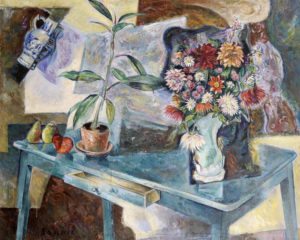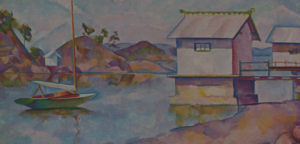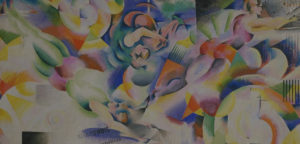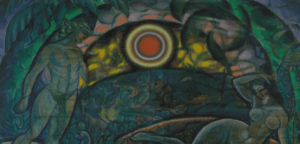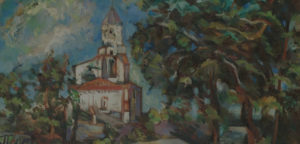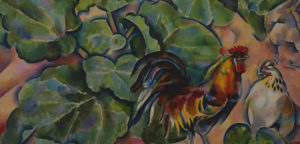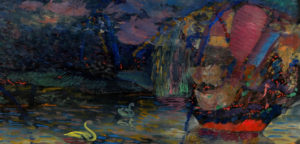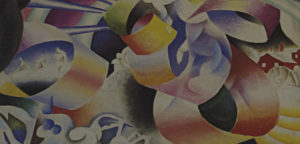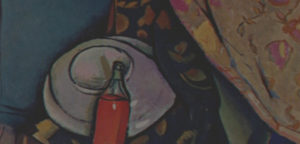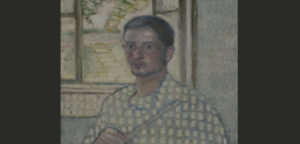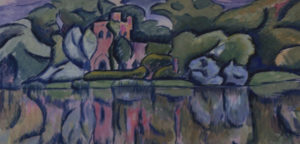He studied at the Odessa Art School, received a diploma in drawing and painting teaching. As a student, he took part in exhibitions of the “Association of South Russian Artists”. He met Burliuk, worked with them in the open air.
1888 - 1944
Wladimir Baranoff-Rossine
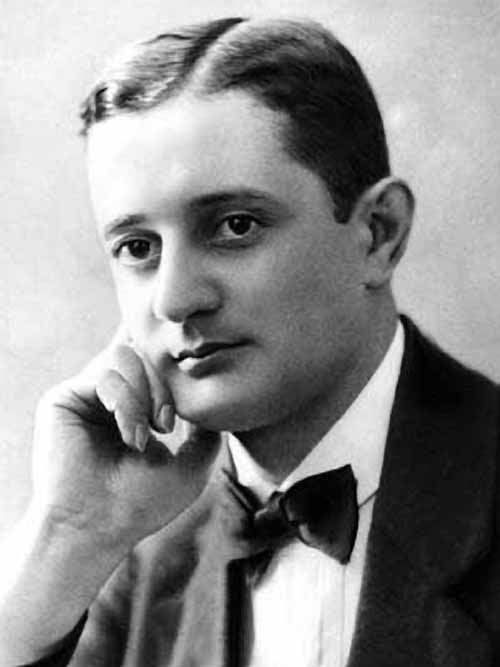
description
A Ukrainian artist of Jewish origin, a painter, draftsman and sculptor, as well as an inventor who lived and worked in Paris for many years. Born under the name Shulim Wolf Leib Baranov.
Baranoff-Rossine was a vivid representative of the Ukrainian and Russian avant-garde. He was recognized throughout Europe and the United States. He invented the color-visual clavier and presented “bell-ring” concerts at the theaters of Russia, France, the Netherlands and the USA. In the Paris Center of G. Pompidou, there is the device itself and the Gallery of visual effects of the opophonic piano.
Constantly experimenting with color and light effects, Wladimir Davydovich applied them in the military art, having developed the technique of camouflage in 1939. Baranoff was officially registered as the inventor of the “photochromometer”, which allowed to determine the quality of precious stones, as well as the machine “Multiperko”, which produced, sterilized, poured carbonated drinks. His inventions received several technical awards, which, unfortunately, did not save the Jewish artist from the Auschwitz gas chamber in 1944.
In 1972, the artist’s family gave 38 works to the Museum of Modern Art in Paris; his son Dmitry restored the color music piano, which was exhibited in the hall of the Pompidou Center. The artist was presented in 1972 at the exhibition “Significant paintings of Russian artists in French collections”, works have been exhibited around the world, in particular, retrospectives at the Tretyakov Gallery in 2002, at the Russian Museum and the Pushkin Museum in 2007.
Key ideas:
– Being a student of the Odessa Art School, Shulim actively participated in the exhibitions of the Association of South Russian Artists. He demonstrated outstanding mastery of the portraitist. For example, the famous “Self-portrait with a brush” (1907), masterfully executed in the style of pointillism by the 19-year-old author. Later on, Baranoff-Rossine created many self-portraits in different styles.
– The artist’s search was aimed at the depiction of the movement in the original version – he used spirally overlapping and flowing into each other bands as the main composition form. The principle of Mobius band, according to Baranoff, best conveys the constant movement of the space itself. Stripes in the paintings of the artist could be colorful or tonally close to monochrome, as seen in the painting “Pink”.
– Another no less significant development of Baranoff is “mobile sculptures”. Called by the critics “paradoxical assembly”, sculpture “Symphony No. 2” was a collage of many objects (springs, disks, etc.), intricately connected by metal ribbons, painted in bright colors. The dead sculpture (the author threw it into the Seine) is determined by art historians as the predecessor of Dadaistic collages. It was static, although later Baranov created moving compositions.
– Trying to match music and an image, Vladimir Baranoff created an apparatus with such a system of keys that allowed to project more than three thousand shades of spectrum onto the screen. The restored original is exhibited at the Center of G. Pompidou, Paris, where a special gallery of visual images of the instrument, transferred from disks to paintings, was also created.
1888
1903 - 1907
1910 - 1914
1915 - 1917
1917 - 1919
1919
1922 - 1924
1925 - 1928
1930
1940
1943 - 1944
He studied at the Odessa Art School
He entered the Academy of Arts in St. Petersburg
He entered the Academy of Arts in St. Petersburg. Participated in the presentation of the band “The Wreath Stefanos”, as well as in the avant-garde exhibition of the group “Zveno”, organized by Burliuks in Kiev, Kherson, Ekaterinoslav, Petersburg and Vilnius; in the exhibition “Impressionists” (St. Petersburg, Vilnius, Berlin).
He went to Paris
Not graduating from the Academy, he went to Paris, took the pseudonym Daniel Rossine. Got acquainted with R. Delaunay, became carried away by Orphism. He exhibited his works at the Salon of Independent with Archipenko, Exter, Burliuk, Malevich, as well as at avant-garde exhibitions in Zurich and Amsterdam. He created the multicolored sculpture “Symphony No. 2” of “paradoxical” materials – the work was ridiculed, but attracted the favorable attention of G. Appoliner. The author threw his, according to critics, “monstrous assemblage” into the Seine.
He went to Norway
He went to Norway, where he exhibited his vernissage in Christiania (Oslo) in Stockholm, showing the first color-light shows with the help of the device-optophone invented by him, which combined music and a color. Encouraged by success, he worked on a new plastic principle based on the use of Möbius tape.
Changed his surname to Baranoff-Rossine
Changed his surname to Baranoff-Rossine, returned to Russia, where he soon exhibited his works together with the Union of Art in Petrograd and Moscow, the group “Jewish Society for the Promotion of Art”, Altman, El-Lisitsky, etc. Participated in the shows of the Art Bureau of Dobychina (60 works). He organized a workshop at the former Academy of Arts.
Moved to Moscow
Moved to Moscow in connection with being appointed to the position of the Professor of Vkhutemas (Higher Art and Technical Studios), was a member of the College of Arts. He created abstract, almost Suprematist simple compositions. Married, but widowed a year later – his wife died after the birth of her son Eugene.
His works were exhibited in the Van Diemen Gallery
His works were exhibited in the Van Diemen Gallery at the First Russian Art Exhibition in Berlin. Having improved the opto-piano, he gave “visual” concerts with his second wife Polina Bucur at the Meyerhold Theater and at the Grand Theater.
He gave optophone concerts in Paris
Despite the success, he left the USSR, went to France. He gave optophone concerts in Paris, Riga, Berlin. He founded the first Ophophonic Academy, continued audiovisual research work. His second son Michelle was born.
Exhibited his works at the Salon of Independent
Exhibited his works at the Salon of Independent, at the Paris International Exhibition, at the salon of the New Realities, in a special vernissage of music artists in Limoges. His daughter Tatyana was born. Applied the art of colors in military practice – “pointillist disguise” (learnt from R. Delone).
Constantly experimented
Constantly experimented, inventing the “Photo Chronometer” to determine the quality of precious stones, the device for the production of carbonated drinks “Multperko”. He received a number of technical patents and special awards. His son Dmitry was born.
He was killed in the Auschwitz concentration camp
The artist, who already had international recognition, refused to emigrate to the US and was caught by the Gestapo and sent to Poland as a representative of Jewish nationality; there he was killed in the Auschwitz concentration camp.
Wladimir Baranoff-Rossine
On Artist
flow
Post-impressionism
friends
Mikhail Larionov
Robert Delone
Mark Shagal
artists
Paul Cezanne
Kazimir Malevich
Henri Matisse
Pablo Picasso
Paul Signac
By Artist
flow
Orphism
Surrealism
friends
Abram Manevich
Nikolai Petrovich Glushchenko
Natalia Goncharova
David Burliuk
Alexandra Exter
Osip Zadkine
Oleksandr Archipenko
Chaim Soutine
Amedeo Modigliani
Sonya Delone

